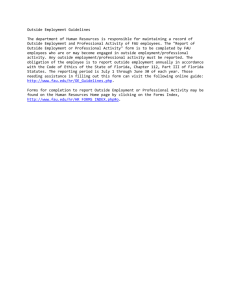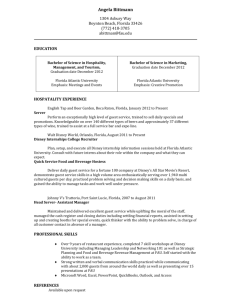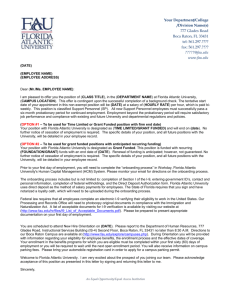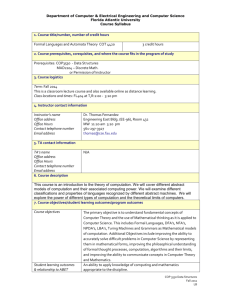5.6 MB ppt - State University System of Florida
advertisement
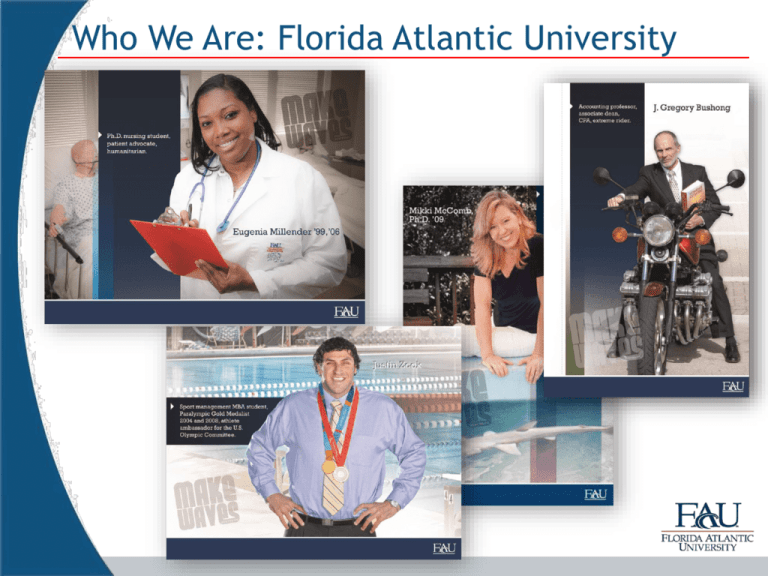
Who We Are: Florida Atlantic University Who We Are: Florida Atlantic University • 3,655,271 Floridians in service area • 27,700 students • 590 tenure-earning faculty • 81% undergraduate/19% graduate • Carnegie Class – RU/H: Research Universities (High Research Activity) • 7 sites spanning 150 miles • 47% part-time students (largest % in SUS) • 19% African-American, 17% Hispanic • 30% of undergraduates receive Pell Grants • 90% commuter students • 35,000 Lifelong Learning course registrations • Economic impact exceeds $1.2 billion Who We Are: Florida Atlantic University Core Strengths FAU serves the new “traditional” student: older, part-time, employed, lower income, minority • Enrollment reflects the characteristics of service region • Minority students graduate at same rate as non-minority • Large number of transfer students with strong graduation rates Growing scientific and engineering focus (e.g., Center of Excellence in Ocean Energy Technology) • • Challenges • • • • Improve retention and FTIC graduation rates Increase research funding Expand funding sources Grow graduate education 2 BOT-Approved Peer Institutions for FAU University Florida Atlantic University Total Science & Engineering R&D 6-Year Freshman Expenditures, Total % Graduate Graduation Retention, FY 08 Enrollment of Total Rate 2008 to ($ in thousands) Fall 2009 Enrollment 2003 Cohort 2009 27,700 19% 38% 79% $41,788 George Mason University $72,542 32,067 39% 63% 85% Georgia State University $77,709 30,431 26% 50% 83% n/a 30,383 27% 34% 72% Old Dominion University $66,538 24,013 24% 51% 80% Portland State University $27,007 24,942 20% 31% 69% University of Akron, Main Campus $27,182 27,822 17% n/a 69% University of Louisville* $148,936 21,016 26% 48% 78% University of Memphis $43,183 21,424 22% 39% 76% University of Nevada - Las Vegas $50,775 29,069 22% 39% 73% University of Texas-Arlington $43,005 28,085 24% 43% 68% University of Toledo $59,583 23,064 21% 45% 68% University of Wisconsin - Milwaukee $41,285 30,418 17% 43% 73% Virginia Commonwealth University* $148,655 32,436 29% 51% 84% Indiana Univ-Purdue Univ - Indianapolis Approved January 2006 as part of FAU’s strategic plan *Includes medical school •Aspirational peers and goals will be set in FAU’s upcoming strategic planning process 3 The Next 5 – 10 Years Vision: University of first choice for excellent and accessible education • Launch independent College of Medicine – 2011 inaugural class • Transform delivery of academic services, including E-learning, which will increase student capacity, particularly for part-time and adult learners • Increase on-campus housing, which is proven to improve student engagement, graduation rates • Provide new or improved facilities and amenities including student union, health and counseling center, career development and civic engagement center, branch campus classrooms, core research buildings Vision: Collaboration with regional partners • • • • • • • Scripps Florida Max Planck Florida Institute Torrey Pines Institute for Molecular Studies Area hospitals for medical education Florida Initiative for the Advancement of Teaching (FIAT) and regional school districts NOAA Cooperative Institute with University of North Carolina-Wilmington University of Miami Cooperative Institute on Marine and Atmospheric Science (CIMAS) 4 The Next 5 – 10 Years Vision: Contributions to creativity and research Center for Ocean Energy Technology • $15 million in state and federal support for clean, renewable energy • FAU selected as the recipient of EnergyOcean International’s 2010 Academic Pioneer Award Department of Defense-funded HBOI research • Novel underwater laser system and robotics to develop sensing networks for enhanced security of coastal waters and ports The College for Design and Social Inquiry • Community collaboration and revitalization research projects in disaster recovery, public transportation and housing construction Center for Advanced Knowledge Enablement (CAKE), an NSF-supported center in the College of Engineering and Computer Science • A collaboration with FIU for faculty and industry to jointly pursue advanced research in information technology, communication and computing Commercial Music Program • Students develop skills for a professional music career and study the business of music The Klezmer Company Orchestra • FAU Libraries' professional ensemble-in-residence showcases the music archives through performances and outreach 5 FAU’s Contribution to System and New Florida Investment in Harbor Branch Oceanographic Institute • Dynamic research climate will attract research-productive faculty focusing on marine ecosystems, aquaculture and biomedicines Joint M.D./Ph.D. program with Scripps Research Institute • Prepare physician scientists who will rapidly apply research findings to modern clinical medicine Strengthen South Florida workforce • • • • • Increase degree production in STEM, health professions and education degrees Increase access to educational opportunities for working adults Increase number of degrees to African-American, Hispanic and Pell Grant students Sixth largest College of Business in U.S. produces 1,600 graduates annually School of Accounting ranks in top 10 in the U.S. Economic Development • Partnered in establishing the Max Planck Florida Institute at FAU • Established Adams Center for Entrepreneurship in the College of Business • Developing a university-wide platform for entrepreneurship 6 1 - 3 Year Initiatives for Work Plan Funding derived from a five-year plan that leases broadband frequencies under FCC permit and from strategic internal allocations. These initiatives are in their third year of implementation. 1) Promote success and retention of FTIC students • Improved instruction in math courses • Supplemental Instruction (SI) Increase in Pass Rates with SI Fall 2006 to Fall 2009 % Increase • College Algebra 92% Methods of Calculus 55% Math for Liberal Arts 28% Introductory Statistics 12% Faculty learning communities focused on pedagogy of teaching 7 1 – 3 Year Initiatives for Work Plan 2) Division of Research identified priority areas for focused research through a competitive proposal process for interdisciplinary teams: -Climate change -Brain function, damage and repair -Healthy aging • Internally funded over three years • Each area expected to generate major external funding 3) Provided competitive start-up packages to attract world-class research-active faculty to FAU 4) Strengthen technological infrastructure to offer faster, more reliable and scalable services for teaching, research, service and administration • 20% of classroom instructional technology updated annually • Network infrastructure replaced • E-learning centrally supported 8 Enrollment Plan • Major revision to enrollment plan will occur with new strategic planning process • Project growth at upper division and graduate levels for in-state residents • Evolving relationships with State Colleges expected to impact enrollment, especially for potential transfer students • Increase quality and diversity of out-of-state and international students through marketing and scholarships • Expand E-learning opportunities to increase capacity unrestrained by space limitations • Increase FTICs through new campus amenities and reputation for excellence • Inaugural medical school class in fall 2011; 256 medical students by 2015 9 New Degrees Under Development • Three additional professional science master’s degrees in employment growth areas: -Cyber and information security -Architecture -Science journalism • Ph.D. in Sustainable Infrastructure Engineering -FAU’s new College of Engineering and Computer Science building will be the first platinum-LEED-certified academic research building in Florida and will serve as a living laboratory for energy-efficient practices 10 Differential Tuition $300,000,000 Authority to charge differential tuition UF, FSU, USF UF, FSU, USF, UCF, FIU All SUS All SUS $250,000,000 $200,000,000 E&G dollars Federal Stabilization Fund Tuition Differential $150,000,000 Tuition & Fees Fixed Costs (GR/Lottery) Academic Mission (GR/Lottery) $100,000,000 $50,000,000 $0 2006-07 2007-08 2008-09 2009-10 2010-11 • In 2009-10, the tuition differential preserved 250 course sections corresponding to over 10,000 enrollments (English, chemistry, math, Spanish, other high demand courses) • To date, 310 students have received need-based aid of $2,000 each. 11 Differential Tuition: 2010-11 • 7% requested • Will generate $4,477,776 • $1,343,333 for financial aid - 670 students will receive $2,000 each in additional need-based aid • Improvement of academic advising and tutoring • Nine academic advisors hired for fall 2010 to decrease student/advisor ratio and improve student success • Supplemental instruction to be offered in 110 course sections • Improved access to academic courses • 300 undergraduate course sections retained with 15,000 student enrollments • General education courses will be the first target to facilitate students’ timely progression to degree • Continue to hire high quality faculty -Tenure-earning faculty from Cornell University, Harvard University, Stanford University, Ohio State University and the University of Pennsylvania • Effectiveness of differential tuition will be continually measured. Expected outcomes include lessening unmet course demand, maintaining faculty/student ratio, improving student/advisor ratio and ensuring student progression toward degree. 12 Looking Forward FAU eagerly embraces its promise as a rapidly maturing member of the State University System and an ever-increasing asset to the people of Florida. 12
